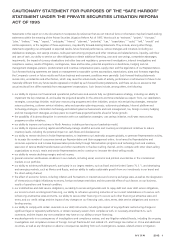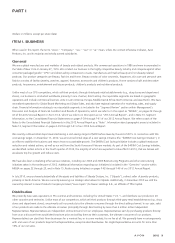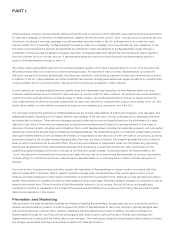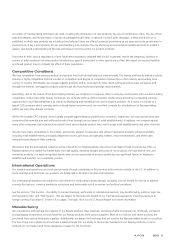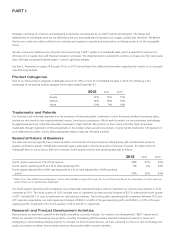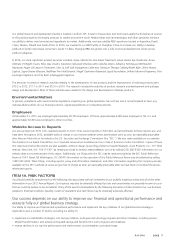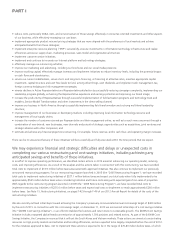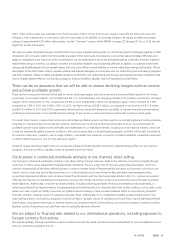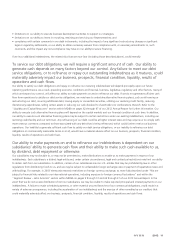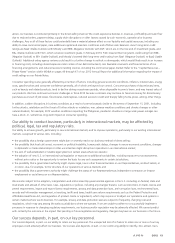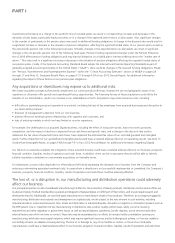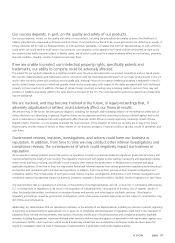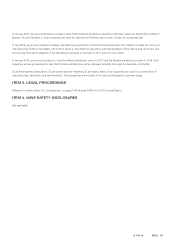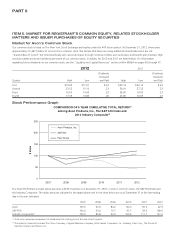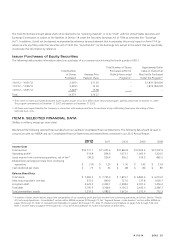Avon 2012 Annual Report Download - page 18
Download and view the complete annual report
Please find page 18 of the 2012 Avon annual report below. You can navigate through the pages in the report by either clicking on the pages listed below, or by using the keyword search tool below to find specific information within the annual report.• limitations on our ability to execute business development activities to support our strategies;
• limitations on our ability to invest in recruiting, retaining and servicing our Representatives; and
• compliance with certain covenants in our debt instruments, including the impact of any significant restructuring charges or significant
legal or regulatory settlements, or our ability to obtain necessary waivers from compliance with, or necessary amendments to, such
covenants, and the impact any non-compliance may have on our ability to secure financing.
If we incur additional indebtedness, the related risks that we now face (including those described above), could intensify.
To service our debt obligations, we will require a significant amount of cash. Our ability to
generate cash depends on many factors beyond our control. Any failure to meet our debt
service obligations, or to refinance or repay our outstanding indebtedness as it matures, could
materially adversely impact our business, prospects, financial condition, liquidity, results of
operations and cash flows.
Our ability to satisfy our debt obligations and repay or refinance our maturing indebtedness will depend principally upon our future
operating performance. As a result, prevailing economic conditions and financial, business, legislative, regulatory and other factors, many of
which are beyond our control, will affect our ability to make payments on and to refinance our debt. If we do not generate sufficient cash
flow from operations to satisfy our debt service obligations, we may have to undertake alternative financing plans, such as refinancing or
restructuring our debt, incurring additional debt, issuing equity or convertible securities, utilizing our revolving credit facility, reducing
discretionary expenditures, selling certain assets or reducing our cash dividend to shareholders (or combinations thereof). Refer to the
“Liquidity and Capital Resources” section within MD&A on pages 42 through 47 of our 2012 Annual Report for further information. Our
ability to execute such alternative financing plans will depend on the capital markets and our financial condition at such time. In addition,
our ability to execute such alternative financing plans may be subject to certain restrictions under our existing indebtedness, including our
revolving credit facility and our term loan. Any refinancing of our debt could be at higher interest rates and may require us to comply with
more onerous covenants compared to those associated with any debt that is being refinanced, which could further restrict our business
operations. Our inability to generate sufficient cash flow to satisfy our debt service obligations, or our inability to refinance our debt
obligations on commercially reasonable terms or at all, would have a material adverse effect on our business, prospects, financial condition,
liquidity, results of operations and cash flows.
Our ability to make payments on and to refinance our indebtedness is dependent on our
subsidiaries’ ability to generate cash flow and their ability to make such cash available to us,
by dividend, debt repayment or otherwise.
Our subsidiaries may not be able to, or may not be permitted to, make distributions to enable us to make payments in respect of our
indebtedness. Each subsidiary is a distinct legal entity and, under certain circumstances, legal and contractual restrictions may limit our ability
to obtain cash from our subsidiaries. In addition, certain of our subsidiaries are non-U.S. entities that may be prohibited by law or other
regulations from distributing funds to us, and we may be subject to unfavorable foreign exchange rates or payment of repatriation taxes and
withholdings. For example, in 2003 Venezuela enacted restrictions on foreign currency exchange, as more fully described under “We are
subject to financial risks related to our international operations, including exposure to foreign currency fluctuations” and within the
“Segment Review – Latin America” section within MD&A on pages 9 through 10 and 34 through 37 of our 2012 Annual Report. In the
event that we do not receive distributions from our subsidiaries, we may be unable to make required principal and interest payments on our
indebtedness. A failure to make scheduled payments, or other material uncured breaches of our contractual obligations, could result in a
variety of adverse consequences, including the acceleration of our indebtedness and the exercise of other remedies by our creditors that
could materially adversely affect our business, prospects, financial condition, liquidity, results of operations and cash flows.
A V O N 2012 11


